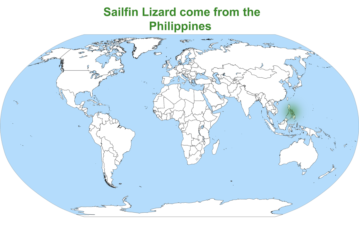Sailfin Lizard
Reptilarium Animals
Weber's Sailfin Lizard
Conservation status (Vulnerable)


The Philippine sailfin lizard, crested lizard, sail-fin lizard, sailfin water lizard, soa-soa water lizard (Hydrosaurus pustulatus ) or its native name ibid is an oviparous lizard endemic to several of the islands that make up the Philippines and is also found in New Guinea and some parts of Eastern Indonesia. The Philippine Sailfin Lizard is a protected species in its native country of the Philippines as it is a target for exotic pet collectors and sought after in the international pet trade. This is largely because these lizards have unique dorsal crests (otherwise known as sailfins) that give the organism a structure similar to a sail, and the Philippine Sailfin Lizard also has very bright coloration patterns that make them attractive to the eye. The pustulatus species is unique within the Hydrosaurus genus because of the confusion for the past several decades of classifying these organisms amongst other lizards within their same genus in their habitat. They are also very talented swimmers, and smaller juvenile lizards can run on top of water due to their bodily structure. The genus Hydrosaurus means water dragon, which reflects the aforementioned abilities lizards have in water. The Philippine sailfin lizard usually lies close to bodies of water, stays in tree branches, and runs across the ground to get around their habitat. They utilize their sailfins/scales to do territorial displays in the presence of a competitor or a predator. In terms of their reproduction, they utilize sexual reproduction and breed one time each year, but they can produce multiple clutches of eggs with between 2 and 8 eggs. These eggs are buried into the soil for a period of two months before hatchlings are produced. Philippine sailfin lizards are heavily studied by herpetologists and other scientists, as they are unique amongst other reptile lizards with regard to their coloration and form.

The Philippine sailfin lizards are omnivores and they eat plants including leaves and fruits in addition to insects and crustaceans. Juvenile Philippine sailfin lizards start out preferring meat more than plants, but the balance comes as they age. Their diet is easy to replicate, which is why they are a target for exotic pet collectors, but they’re not as docile compared to other lizards. The Philippine sailfin lizard’s omnivorous diet is also reflected by its relatively simple dental complexity, specifically with the posterior teeth of the mouth having less defined tricuspid teeth and the posterior teeth being tricuspid. As a result, the lizard cannot primarily be a carnivore since its teeth were not designed to do so.
Philippine sailfin lizards have now been classified as Vulnerable by the IUCN. Their main threats are habitat loss, being hunted for food, and collection for the pet trade. The factors contributing to this vulnerable conservation status include habitat loss, hunting by exotic meat collectors and the pet trade. It is currently illegal according to Philippine law to export the lizard out of the country, but some exotic pet collectors claim to already be in possession of these lizards and breed them in captivity to sell them to buyers in the United States of America. In fact, the median price for these lizards is $700, which is considerably more expensive than other lizards. Some of the most well known trading centres for the Philippine sailfin lizards are 1) Puerto Princesa City, Palawan Island, 2) Cebu City, Cebu Island, and 3) Davao City, Mindanao Island. It’s essential that conservation efforts to create protected areas within the Philippines for the Philippine Sailfin Lizard are within the habitats that they normally live in and not these trading areas. In terms of the history of the pet trade, Philippine sailfin lizards were sold in higher frequency between 1980 and 1990 because the Philippines as a country was exporting them internationally, but they now do not export these lizards anymore, leaving Indonesia to be the primary source of exporting them.

